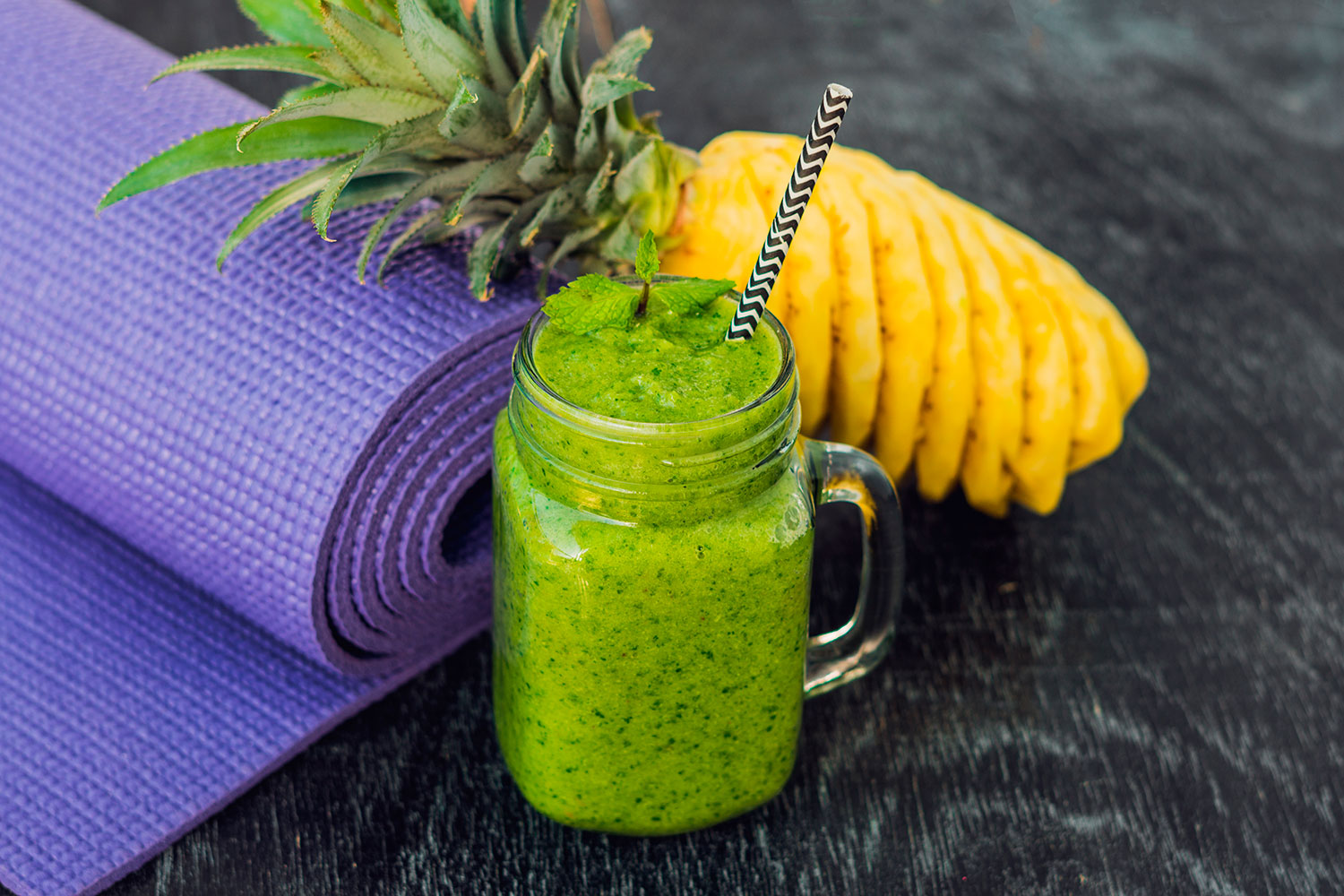
Rose graduated with a degree in Anthropology, which takes her…
When adopting the yoga lifestyle, many people become curious about how to eat like a yogi. In yoga class, you learn poses and breathing techniques and even some Sanskrit. But what happens when you step off the mat? Yoga does not teach one specific diet, cleanse, or way to eat. Instead, there are many aspects of yoga philosophy, that when considered together, can influence a yogi’s decisions in the kitchen. Nevertheless, there are some changes you can incorporate in your diet or routine when it comes to eating like a yogi.
Should Yogis Eat A Certain Way?

In a word – no. There are no hard and fast rules for how to eat like a yogi. Eating a potato chip or drinking a glass of wine does not make you a ‘bad yogi’ – they make you a real and dimensional person. Some yogis eat meat and some yogis eat vegetarian. Some yogis follow strict Ayurvedic principles. Some yogis recommend ‘yoga diets,’ whereas others argue that trying to follow a specific diet can lead to health-damaging obsessions. It can be difficult for yogis to navigate this confusing conversation regarding how to eat. Contradictory advice will be given, suggested, and even forcibly presented as dogma. Ultimately, however, each person must follow their own unique path and make their own decisions about what to eat. Every person’s body is unique and the fuel they choose should reflect that.
How Yoga Inspires People To Change Their Diet

Yoga inspires people to change how they eat because it changes how they think and feel about themselves and the world around you. Becoming a yogi is a lifestyle shift toward a more mindful existence that focuses on the union between the self and its surroundings. Naturally, these shifts will transfer to diet and food, too.
Even the most thorough change happens once choice at a time. Charles Eisenstein
The first changes may be subtle. Maybe you do not pull out the ‘junk’ food after a yoga practice. Maybe you slowly start to quit mindlessly binging on food, because you mind senses when your body is full. Maybe you stop craving sugary foods and start craving foods that will fuel your body and get you through a long practice. Maybe you even begin to think about how your decisions about food affect the world around you… from environmental issues to ethical ones. There are so many ways that the thinking behind your yoga practice may start to infiltrate your diet. Because of this, many people find themselves inspired to adopt new diets that make them feel both better about themselves and better about the world around them.
What Yoga Philosophy Says About Your Diet
Just because there is not a strict ‘yoga diet’ for everyone, does not mean that yoga philosophy has nothing to say on the matter. On the contrary, there are many principles of yoga that can contribute to the decisions you make around food. When studying yoga philosophy, one usually begins in the yamas and niyamas. These are philosophical principles that make up the first and second limbs of yoga. Yamas refer to ethical guidelines, whereas the niyamas refer to self-discipline practices. Another way to think of this is that the yamas are recommendations for things not to do, whilst the niyamas are things to do. Below, three specific yamas and niyamas discussed, which can be interpreted to influence diet.
Ahimsa

Ahimsa is the first of the yamas. The translation from Sanskrit is ‘nonviolence.’ Many people take the meaning of nonviolence literally, and only in its most obvious physical form: to not physically harm other beings. This is why many yogis are vegetarian or vegan. As a person who lives by the principles of nonviolence, it makes sense to not eat meat which was sourced through violent measures to other living beings.
However, do all yogis have to be vegetarian or vegan? Is this a sustainable lifestyle for everyone? Not everyone thinks so. The principle of ahimsa is much more than just restraining from causing physical violence to other beings. Nonviolence should also include how a person thinks about themselves, treats themselves, thinks or treats others, and more. Ahimsa is a very holistic definition of nonviolence. For example, one yogi found that her body functioned better when she ate meat. After trying countless times to be vegetarian, she noticed that she became anemic. After all, every person’s body is unique and some bodies will not react to a vegetarian or vegan diet as well as others. As this yogi phrased it, by not eating meat, she was actually inflicting violence on her body; she was not nourishing it the way it deserved. By making the decision to eat meat, she is actually acting with ahimsa toward her own body. This is one argument that yogis can eat meat.
Another example of how ahimsa can be included in a yogi’s diet is regarding restriction. It is common for people to count calories or restrict food intake as a way of ‘punishing’ themselves – whether that punishment is based on making up for a ‘cheat day,’ punishment for how they look, or as an emotional form of punishment. In all of these situations, food is not being used with ahimsa. Instead, it is a vehicle for violence against the body and spirit. To eat like a yogi, accept and include the principle of ahimsa when nourishing the body.
Santosha
Santosha is the second niyama. It means ‘complete contentment.’ Similarly to ahimsa, however, there is more to this definition than meets the eye. Is it possible to ever be completely content? Complete contentment comes not from filling your life with the best possible things, or achieving some far-off dream scenario. Instead, yoga teaches that complete contentment is not dependent on external factors and stimuli: Santosha is found from within. Regardless of your circumstances, everyone can find santosha in the present moment.
But how does santosha translate to eating? Many people have a habit of mindlessly eating. Maybe this presents as snacking to distract from the present moment, speed eating to move onto the next obligation, or eating in front of the TV. In all of these situations, the person is using food as a coping mechanism or distraction. To eat like a yogi, cultivate santosha during your meals. Sit still and be grateful for your food and your body, and really notice your food as you eat it. Notice the feelings that come up, and find santosha in the present moment, whatever it may be.
Aparigraha

Aparigraha is the fifth yama. It translates to ‘non attachment’ and is all about letting go of attachments or expectations, to people, things, emotions, yoga poses, and more. Of course, aparigraha can also be applied to how a person eats. You may think that a yogi eats a plant-based, completely healthy diet. But even a seemingly healthy diet can have its downsides when it reaches the point of obsession. The risk comes when a person becomes overly attached to a rigid routine, shunning certain foods out of fear. Release attachment to ideals of how a yogi should eat, and do not punish yourself for treats or straying from strictly ‘healthy’ foods.
Aparigraha can also be translated as ‘non greed’ or ‘non hoarding.’ Consider all the ways you may be greedy with food. Do you eat even when you are already uncomfortably full? Do you eat if something is placed in front of you, even if you aren’t hungry? Do you partake in the Western massive portion sizes? One yogi even refers to this as ‘hoarding’ calories. To practice aparigraha, let go of your poverty mentality and only eat food when you are actually hungry.
Ayurveda and Diet
It is difficult to talk about yoga without the topic of ayurvedic science coming up. This is perhaps never more true than when discussion how yogis should eat. Yoga and Ayurveda are interconnected systems that inform one another, yet are unique. Yoga and Ayurveda are both based on the ancient Vedic teachings of Indian scholars. Ayurveda, unlike yoga, is a traditional medical system that conceptualizes health and disease, and its causes, within the body.
Specifically, Ayurveda makes recommendations about diet. Many yogis follow ayurvedic principles when they eat, as it is a complementary system to yoga. Ayurveda uses a system called ‘doshas’ to recommend diets that are unique to individuals. The doshas are similar to personality types, but they also encompass physical, constitutional, and internal aspects. In other words, they include the mind-body connection, just as yoga does. Additionally, the doshas are based off of the five elements. A person can also have a combination of doshas, their dosha may change over time, or become imbalanced. Knowledge of the ayurvedic doshas gives yogis more knowledge and tools when deciding what and how to eat.
Vata Dosha Diet

The vata dosha is aligned with the elements of space and air. As such, a vata individual will have personal qualities that reflect these elements. Vata dosha is characterized by energy, movement, quick thinking, flexibility, and creativity. People who are vata may be thin and always busy or on the go. They are likely to have dry skin and sleep lightly. When in balance, a vata is creative and energetic. However, when out of balance they experience digestive woes such as constipation, anxiety, weight loss, and more. If a person is a vata but out of balance, they may particularly benefit from following a vata-based diet.
For optimal balance, a vata should follow certain dietary guidelines. They should make sure to eat large and warm meals, to balance the airy quality they already possess. A vata person will also thrive on oily or moist foods. They should focus on natural sugars and sweet foods, and avoid bitter foods. Examples of good foods for balancing the vata dosha are berries, dates, peaches, pistachios, and more.
Kapha Dosha Diet
The kapha dosha is associated with earth and water elements. A balanced and healthy kapha dosha is grounded, steady, soft, solid, peaceful, and loving. These reflect the steady qualities of the earth element. However, a kapha risks becoming imbalanced when they rely too heavily on routine or sameness. In a state of imbalance, the kapha dosha person may gain weight, become depressed, become avoidant, hoard items or relationships, and experience feelings of lethargy. It can be challenging to tip a kapha dosha back into balance, but steps can be taken through finding stimulation and change in the persons’ lifestyle, and also within their diet.
To balance a kapha dosha, the diet should consist of light and fresh foods. These more airy qualities will balance the heavy and solid earth element. The person should consume spices, bitter foods, astringent foods, whole foods, and lots of vegetables. They should avoid sweet and sour foods. In other words, the kapha dosha eats in near opposite to the vata dosha. Example foods that a person who is predominantly kapha should eat include spices like chilies or turmeric, bitter greens, eggplant, dark chocolate, lentils, cauliflower, and more.
Pitta Dosha Diet

People with the pitta dosha are aligned with the elements of both fire and water. These two seemingly opposite elements reflect the unique quality of pitta individuals. Pittas are often described as fiery, for their temperament and metabolism. Unlike the generally thin vatas or the heavier-set kaphas, the pittas are of a more medium build. They are vibrant people with strong wills, strong digestion, and strong appetites. However, the fiery nature of pittas can ‘backfire’ when they become imbalanced. A pitta imbalance leads to acidic issues such as acid reflux, heartburn, indigestion, and rashes. Emotionally, the pitta will be angry, frustrated, and experience emotional outbursts. All of these symptoms are easily linked to the fire element that represents pitta dosha.
To balance a pitta dosha, a person must consume pitta pacifying foods. To quell the fire, they should focus on cooling foods. This refers to both the temperature and consistency of the food. Heavy, dense, and mild foods will also balance the fiery components of pitta. Examples of specific pitta balancing foods include celery, cabbage, melons, avocado, kale, chicken, and more. Notice that these do not include sour and salty foods which may exacerbate indigestion.
Bidosha Dosha Diet
A bidoshic individual is equally influenced by two of the doshas. This is actually quite common, and represents a more fluid mind-body connection that is not as strongly dominated by one dosha. A bidoshic person could be pitta-kapha, kapha-vata, or pitta-vata. As such, it may be slightly more complicated for them to balance their doshas and determine what to eat. They may notice themselves tending toward one of their doshas more strongly. During that time it would be wise to eat foods supporting their lesser dosha, so as to balance their constitution. Additionally, to ensure a state of balance, a bidoshic individual should examine their two dominant doshas and identify any overlapping foods that pacify both doshas. They should try to focus on these bidoshic foods within their diet.
Tridosha Dosha Diet

The rarest are tridoshic people, who have nearly equal levels of each dosha in their temperament. In constitution, they benefit from the best qualities of all three doshas: they are strong, quick-witted, creative, calm, tolerant, and loving. However, they likewise share the worst qualities of each dosha when they are imbalanced: they can become lethargic, anxious, irritable, and even cycle between these. After reading about the vata, pitta, and kapha doshas, you may notice that the doshas naturally complement each other and contain opposite qualities. Whilst the vatas are light and need sweet foods, the kaphas are grounded and are irritated by sweet foods. It is, therefore, very challenging for a tridoshic individual to balance themselves when their doshas exist, apparently, in contrast to each other.
As a result, a tridoshic individual should focus less on specific foods, and more on cultivating a routine. A routine that involves an early wake up, regular elimination, gentle movement, and massage will support all three doshas. If they notice one dosha is becoming particularly dominant or imbalanced, they can also use the principles behind that dosha to influence their diet.
So How Should A Yogi Eat?

According to Ayurveda, there is no one, strict diet that all people should follow. Instead, the ideal diet depends on the unique individual. Even for individuals, recommended diet shifts and fluctuates over time based on their personal circumstances. Likewise, the teachings of yoga’s yamas and niyamas have many interpretations and will carry different meanings for different individuals.
Many would agree that a yogi should eat a somewhat plant-based diet, consume fresh foods, not overeat, refrain from eating immediately before practicing physical asana, and not mindlessly binge eat. On the other hand, following aparigraha (‘non attachment’), the yogi shouldn’t become too attached to these rules of how to eat like a yogi.
Ultimately if you practice yoga, you get to decide for your own individual mind and body how to best fuel yourself. Part of the journey and practice of yoga is learning how to nourish yourself, what your body is asking for, and how it deserves to be treated. This will look different for everyone, and that is okay.
What's Your Reaction?
Rose graduated with a degree in Anthropology, which takes her understanding of basic human needs to a whole new level. Her intelligence and passion for healthy living is reflected in her written work.














